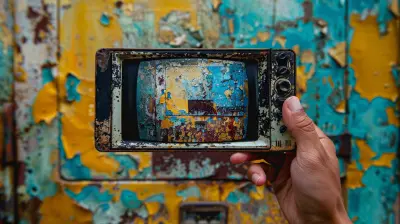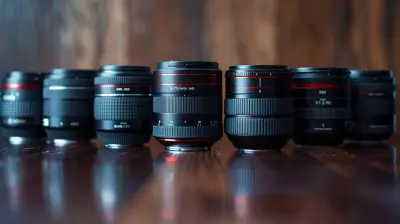13 March 2025
Food photography is a deliciously growing niche, not just for professional photographers but for food bloggers, chefs, or anyone who just loves snapping mouth-watering shots of their meals. But let’s be real—getting that perfect, drool-worthy shot is no piece of cake (pun intended). It’s not just about pointing your camera and clicking the shutter; it’s about choosing the right gear to bring out the textures, colors, and nuances of the food in front of you.
So, whether you're an Instagram food fan or a seasoned professional, picking the right camera gear for food photography can make all the difference. Let’s dive into how to choose the best equipment to create top-tier food photos that look so good, they’ll make anyone want to reach through the screen for a bite.

Camera Body: What’s Your Foundation?
Alright, let’s start with the basics—your camera body. It's the foundation of your photography setup. When it comes to food photography, you don’t need a camera with all the bells and whistles, but you do need one that delivers crisp, high-quality images and performs well in various lighting conditions.DSLR vs. Mirrorless: Which is Better?
The big debate! DSLR or mirrorless? Both have their pros and cons, but for food photography, a mirrorless camera might give you the edge. Why? Mirrorless cameras tend to be more compact and lightweight, making them easier to handle when you're shooting in tight spaces (like a crowded kitchen or a small restaurant). Plus, their electronic viewfinders give you a real-time preview of your exposure and colors, which can save you from a lot of guesswork.On the other hand, DSLR cameras are still a solid choice. They’re often more robust, have longer battery life, and offer a vast array of lenses, which is a plus. If you're already invested in a DSLR system, don't feel like you need to jump ship entirely.
Key Features to Look For:
- High Resolution: Aim for at least 20-24 megapixels. This ensures you capture every little detail in those layers of your lasagna or the delicate frosting on that cupcake.- Full-Frame vs. Crop Sensor: Full-frame sensors will give you a wider field of view, more detail, and better performance in low light. But crop sensors (APS-C) are more affordable and still deliver fantastic results.
- Low Light Performance: Many food shots happen in dimly lit restaurants or kitchens. A camera that performs well at higher ISO levels without excessive noise is a lifesaver.
- Autofocus Speed: You don’t want to miss a shot because your camera took too long to focus on that perfect swirl of whipped cream.
Best Camera Recommendations:
- Sony A7 III (Mirrorless, Full-Frame): Known for its excellent low-light performance and incredible autofocus system. Plus, it's compact, which is a dream for food photographers who shoot in small spaces.- Canon EOS R (Mirrorless, Full-Frame): Great color science and user-friendly interface. Canon's mirrorless series has been making waves in the food photography world.
- Nikon D7500 (DSLR, Crop Sensor): A solid DSLR option with good autofocus and image quality. A bit more affordable than some full-frame options.

The Right Lens: Your Secret Ingredient
Once you’ve sorted your camera body, the next most important choice is the lens. Lenses are to photography what spices are to cooking—they can make or break your shot.Prime vs. Zoom Lenses
When it comes to food photography, prime lenses (those with a fixed focal length) generally take the cake. They tend to offer sharper images, better low-light performance, and give you that beautiful blurred background (bokeh) that can make your food subject really pop. Plus, they often have wider apertures, like f/1.8 or f/1.4, which are ideal for capturing the fine details and textures of food.Zoom lenses, on the other hand, are more versatile in terms of framing, but they can sometimes sacrifice sharpness and aperture size. They’re great if you need flexibility and don’t want to constantly switch lenses, but prime lenses tend to be the go-to for most serious food photographers.
Best Focal Lengths for Food Photography
- 50mm: Often called the “nifty fifty,” this lens is a favorite among food photographers. It’s versatile, affordable, and great for shooting from different angles without distortion.- 85mm: If you're looking for a tighter shot with a beautiful, creamy bokeh, the 85mm is your best friend. It’s perfect for isolating a dish and bringing out the details.
- 35mm: A wider lens that allows you to capture more of the setting or scene. It’s great if you want to include some background context, like the table setting or the chef at work.
Best Lens Recommendations:
- Canon 50mm f/1.8 STM (Prime): Affordable and delivers stunning results. A must-have for anyone starting out.- Sony 85mm f/1.8 (Prime): Stunning sharpness and bokeh for those mouth-watering close-up shots.
- Sigma 35mm f/1.4 DG HSM (Prime): For when you want a wider frame but still need that background blur.

Lighting: The Unsung Hero
Without good lighting, all the camera gear in the world won’t save your shot. Lighting in food photography is everything. Natural light is often the best option because it’s soft and diffused—perfect for bringing out the natural colors and textures in food. But if you’re shooting in a dark restaurant or at night, artificial lighting is your best bet.Natural Light
Natural light is free, and when used correctly, it can create beautiful, soft shadows and highlight the textures of your dish. The best natural light for food photography is indirect, coming from a window or doorway. Direct sunlight can create harsh shadows and overexpose parts of your shot, which you don’t want.Artificial Lighting
If natural light isn’t available, investing in some good artificial lighting is key. Softboxes, LED panels, or even ring lights can help you create that soft, natural look indoors.Key Tips for Lighting:
- Diffuse the Light: Whether it’s natural or artificial, use a diffuser (like a white sheet or professional diffuser) to soften the light and avoid harsh shadows.- Reflectors: These help bounce light back onto your subject and reduce shadows. Even a simple white card or sheet of paper can work as a reflector.
- Avoid On-Camera Flash: This can make your food look flat and unappealing. Always use off-camera lighting if possible.
Best Lighting Gear:
- Neewer 18-inch LED Ring Light: Affordable and easy to use, great for food photography in low-light conditions.- Godox SL60W LED Video Light: A powerful light source with adjustable brightness. Perfect for creating a professional-looking setup.

Tripod: Stability is Key
Shooting handheld might work in some situations, but for food photography, a tripod is essential. It gives you the stability you need, especially in low-light conditions where longer exposure times are necessary. Plus, having your camera locked in place allows you to focus on arranging and styling your food without worrying about losing your framing.When choosing a tripod, look for something sturdy but not too bulky. You want it to be strong enough to support your camera and lens but light enough to be portable.
Tripod Recommendations:
- Manfrotto Compact Action Tripod: Lightweight but sturdy, perfect for food photography at home or on location.- Joby GorillaPod 3K Kit: Flexible and versatile. Great for shooting in tight spaces or unconventional angles.
Extra Gear: The Cherry on Top
Here are a few extra pieces of gear that can make your food photography even better:- Remote Shutter Release: Reduces camera shake when taking longer exposures and allows you to focus on food styling.
- Memory Cards: Make sure you have fast, reliable memory cards with plenty of storage. You don’t want your camera to slow down or run out of space mid-shoot.
- Cleaning Kit: Keep your lenses and camera sensor clean to avoid unwanted dust spots in your photos.
Conclusion
Choosing the best camera gear for food photography doesn't have to be overwhelming. Start with a solid camera body, pair it with a high-quality prime lens, and focus on getting your lighting right. The rest is all about practice, creativity, and a little bit of styling magic. Remember, the best gear is the one that helps you tell your food's story in the most mouth-watering way possible.Now go out there, get the right gear, and start creating those Instagram-worthy food shots that’ll have everyone hungry!









Garrett McCray
Just remember: even soggy fries deserve a spotlight!
April 1, 2025 at 12:45 PM